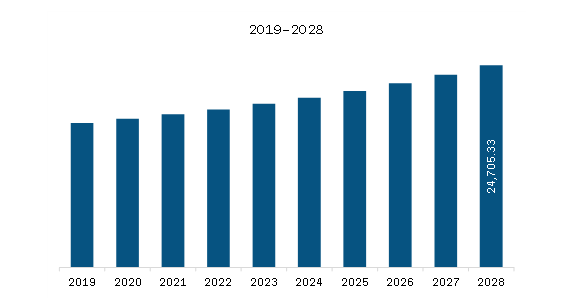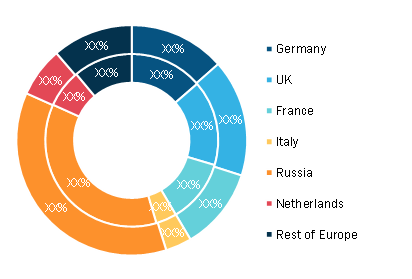The South America antifreeze market accounted to US$ 552.52 million in 2019 and is projected to account US$ 806.69 million by 2027; it is expected to grow at a CAGR of 5.0% during 2020–2027.
Antifreeze is a type of additive that helps in lowering the freezing point in a water based liquid. A mixture of antifreeze is used to obtain freezing point depression for cold environments. With changing and evolving times, antifreeze has been used increasingly in various applications other than being used in automobiles. Antifreeze is produced by mixing water with any one of the four main agents namely, glycerol, ethylene glycol, methanol and propylene glycol. Each of these agents can be put into a variety of uses. Heating, ventilation and air conditioning (HVAC) systems have become an integral part of the modern residences, hospitals, office buildings and ships & submarines. Antifreeze are used in the HVAC systems for preventing the pipes from freezing, bursting and causing damage. It reduces the risk of corrosion and scale build ups. Solar energy is being used all over the world. Antifreeze find application in the solar water heating systems in the form of heat transfer fluid which offer protection from freezing and prevents causing damage to the system. The need of effective heat dissipation and protection against corrosion & heating among the manufactures also require the employment of antifreeze. There is growing demand for antifreeze products and coolants due to the rise in the sale of construction equipment that are used in heavy duty workloads by the manufactures of construction equipment. Other than this, the demand for antifreeze products are increasingly being used in aerospace applications. Freezing temperatures and snowfall lead to perilously ice driveways. The use of non-toxic antifreeze mainly propylene glycol helps in clearing the snow before the spraying of diluted antifreeze over the icy areas. Owing to these attributes antifreeze is employed in different applications which again bode well the growth of the market.
The COVID-19 pandemic first began in Wuhan (China) in December 2019, and since then, it has spread at a fast pace across the globe. As of February 2021, Brazil and Argentina are among the worst-affected countries in terms confirmed cases and reported deaths. The pandemic has been affecting economies and industries in various countries due to lockdowns, travel bans, and business shutdowns. Shutdowns of chemicals and materials industry and disruptions in supply chains due to lockdown of countries has created a strain on the supplies of the various products offered by this industry. In South America, India is the worst-hit country by the COVID–19 outbreak. The government of various countries in the South America has taken necessary steps to reduce its effects by announcing lockdowns, and thus, impacting the growth of the antifreeze market. The introduction of lockdowns has resulted in the halt of construction projects in the region, which negatively impacted the growth of antifreeze in the region. After a prolonged lockdown, various countries have started easing the restrictions. The COVID–19 pandemic will have a short-term impact on the Asia Pacific antifreeze market; however, the market will recover in the coming years.
South America Antifreeze Market

- Sample PDF showcases the content structure and the nature of the information with qualitative and quantitative analysis.
- Request discounts available for Start-Ups & Universities
- Sample PDF showcases the content structure and the nature of the information with qualitative and quantitative analysis.
- Request discounts available for Start-Ups & Universities
Market Insights
Development of Eco-Friendly and Bio-Based Antifreezes
The conventional antifreeze such as ethyl glycol and propylene glycol are vital for the automobiles but at the same time are very toxic to the plants, animals and the environment at large. They are required to be stored and treated with care and must be disposed of properly. However, as per the Agency for Toxic Substances and Disease Registry (ATSDR) propylene glycol is considered to be less toxic and causes harm in small amounts. Glyserol on the other hand enjoy the advantage of being non-toxic, non-corrosive and has the capacity to withstand high temperature which supports its usage as an antifreeze in automobiles. There is a rising demand for environment friendly and bio-based antifreeze and coolants by the automotive manufacturers due to the upsurge in concerns related to the pollutant emission by the vehicles. Hugh quality recycled antifreeze products are now being produced by reclaiming the glycol, a freeze point depressant and consequently stripping all the contaminants & residual corrosion inhibitors from the glycol. The glycol or glycol water mixture is then being used as a raw material for the formulation of an engine coolant and antifreeze that can perform well. Many companies have developed bio-based, ecologically and environment friendly non-toxic antifreeze for process cooling and AC systems which are produced from refined vegetable extracts. The increasing investments by the Government in conducting research & development activities for the development of cost effective, eco-friendly and performance efficient antifreezes creates significant opportunities for the development of the antifreeze market in the long run.
Product Type Based Insights
The antifreeze market based on product type has been segmented into ethylene glycol, propylene glycol, glycerin, and methanol. In 2019, the ethylene glycol segment accounted for a larger share of the South America antifreeze market, whereas the market for propylene glycol is expected to grow at a higher CAGR during the forecast period. Ethylene glycol is an organic compound mainly used as a raw material in the manufacture of polyester fibers and for antifreeze formulations. It is a colorless, odorless, sweet-tasting, viscous liquid. End-user industries highly prefer ethylene glycol-based antifreeze due to its exceptional properties such as the ability to be mixed in any proportion to form coolant, miscibility in water, and others. The production cost of ethylene glycol coolants is less as it requires less energy at various stages of conversions, along with the low cost of raw materials. Thus, ethylene glycol coolants are cost-efficient, and this is also one of the primary factors driving a huge number of customers to opt for ethylene glycol coolants. Earlier, vehicle owners were reluctant to use ethylene glycol owing to its sweet taste and toxic characteristics. The sweet taste of ethylene glycol attracted animals to consume it, which lead to the deaths of pet animals worldwide. Hence, coolant manufacturers started adding a bittering agent in ethylene glycol, and thereafter the product regained its demand in the market. Moreover, the low viscosity and low freezing point properties of ethylene glycol makes it ideal for winter and summer conditions, and hence it is largely adopted in regions like South America.
South America Antifreeze Market, by Product Type – 2019 and 2027

- Sample PDF showcases the content structure and the nature of the information with qualitative and quantitative analysis.
- Request discounts available for Start-Ups & Universities
- Sample PDF showcases the content structure and the nature of the information with qualitative and quantitative analysis.
- Request discounts available for Start-Ups & Universities
Technology Type Based Market Insights
Based on technology type, the antifreeze market is segmented into organic acid technology antifreeze (OAT), inorganic acid technology antifreeze (IAT), and hybrid organic acid technology (HOAT). In 2019, the organic acid technology antifreeze segment dominated the South America antifreeze market and is also expected to grow at the fastest rate during 2020–2027. Organic Acid Technology (OAT) is expected to exhibit a staggering growth over the forecast period. In organic acid technology, the corrosion inhibitors are entirely neutralized organic acids and azoles. OAT antifreeze consists of 2-EHA, sebacate, and numerous organic acids. OAT antifreeze does not contain phosphates or silicates. It is primarily exploited in heavy and light-duty automotive. It has an extended lifespan, which is up to 6 years or 960,000 kilometers for heavy-duty vehicles, whereas, for a lightweight automotive vehicle, its lifespan is up to 5 years or 250,000 kilometers. In addition to this, it offers superior protection to magnesium and aluminum-based engines that are used in modern engines and thereby makes it suitable across the automotive industry. The aforementioned product properties are likely to make a significant contribution to coolants market size in the coming years.
Application Based Market Insights
Based on application, the antifreeze market is segmented into automobile, construction, electronics, and others. In 2019, the automobile segment dominated the South America antifreeze market and the others segment is expected to grow at the fastest rate during 2020–2027. Antifreeze is considerably used in the automotive industry to maintain the optimum temperature inside the vehicle's engine by lowering excess heat which is produced when it runs and thereby avoiding severe damage to its internal component. The rapidly growing automotive industry in South America is driving product demand. For instance, as per the OICA (Organisation Internationale des Constructeurs d'Automobiles), the light commercial vehicle production has grown from 10.4 million units in 2015 to 11.0 million units in 2016. The increased sales of vehicles are attributed to the rising living standards of the populace and increasing per capita income. A similar trend is observed in other regions as well. The automotive sector in developing countries such as China, India, and Indonesia is expanding tremendously. For instance, India's automotive industry has proliferated over the last few years and this expansion in the vehicle's sales has considerably increased the demand for coolants in the country, thereby contributing to the South America market growth.
Customize Research To Suit Your Requirement
We can optimize and tailor the analysis and scope which is unmet through our standard offerings. This flexibility will help you gain the exact information needed for your business planning and decision making.
South America Antifreeze Market: Strategic Insights

Market Size Value in US$ 552.52 Million in 2019 Market Size Value by US$ 806.69 Million by 2027 Growth rate CAGR of 5.0% from 2020-2027 Forecast Period 2020-2027 Base Year 2020

Shejal
Have a question?
Shejal will walk you through a 15-minute call to present the report’s content and answer all queries if you have any.
 Speak to Analyst
Speak to Analyst
Customize Research To Suit Your Requirement
We can optimize and tailor the analysis and scope which is unmet through our standard offerings. This flexibility will help you gain the exact information needed for your business planning and decision making.
South America Antifreeze Market: Strategic Insights

| Market Size Value in | US$ 552.52 Million in 2019 |
| Market Size Value by | US$ 806.69 Million by 2027 |
| Growth rate | CAGR of 5.0% from 2020-2027 |
| Forecast Period | 2020-2027 |
| Base Year | 2020 |

Shejal
Have a question?
Shejal will walk you through a 15-minute call to present the report’s content and answer all queries if you have any.
 Speak to Analyst
Speak to Analyst
Product development, merger and acquisition, and business planning are the commonly adopted strategies by companies to expand their product portfolio. BP p.l.c, Chevron Corporation, BASF SE, CCI Corporation., Old World Industries, LLC, Prestone Products Corporation, Total, Exxon Mobil Corporation and Royal Dutch Shell Plc. are amongst the market players implementing this strategy to enlarge the customer base and gain significant market share in South America, which in turn permits them maintain their brand name in the South America market.
Report Spotlights
- Progressive industry trends in the South America antifreeze market that help players develop effective long-term strategies
- Business growth strategies adopted by developed and developing markets
- Quantitative analysis of the South America antifreeze market from 2017 to 2027
- Estimation of South America antifreeze demand across various industries
- PEST analysis to illustrate the efficacy of buyers and suppliers operating in the industry to predict market growth
- Recent developments to understand the market competition in South America
- Market trends and outlook, coupled with factors driving and restraining the growth of the South America antifreeze market
- Decision-making process by understanding strategies that underpin commercial interest with regard to the South America antifreeze market growth
- South America Antifreeze market size at various nodes of market
- Detailed overview and segmentation of the South America antifreeze market, as well as its dynamics in the industry
- South America antifreeze market size in various regions with promising growth opportunities
South America Antifreeze Market, by Product Type
- Ethylene Glycol
- Propylene Glycol
- Glycerin
- Methanol
South America Antifreeze Market, by Technology Type
- Organic Acid Technology Antifreeze (OAT)
- Inorganic Acid Technology Antifreeze (IAT)
- Hybrid Organic Acid Technology (HOAT)
South America Antifreeze Market, by Application
- Automobile
- Construction
- Electronics
- Others
Company Profiles
- BP p.l.c
- Chevron Corporation
- BASF SE
- CCI Corporation
- Old World Industries, LLC
- Prestone Products Corporation
- Total
- Exxon Mobil Corporation
- Royal Dutch Shell Plc

Report Coverage
Revenue forecast, Company Analysis, Industry landscape, Growth factors, and Trends

Segment Covered
Product Type, Technology Type, Application

Regional Scope
North America, Europe, Asia Pacific, Middle East & Africa, South & Central America

Country Scope
US, Canada, Brazil, Argentina
1. Introduction
1.1 Study Scope
1.2 The Insight Partners Research Report Guidance
1.3 Market Segmentation
2. Key Takeaways
3. Research Methodology
3.1 Scope of the Study
3.2 Research Methodology
3.2.1 Data Collection:
3.2.2 Primary Interviews:
3.2.3 Hypothesis formulation:
3.2.4 Macro-economic factor analysis:
3.2.5 Developing base number:
3.2.6 Data Triangulation:
3.2.7 Country level data:
4. Antifreeze Market Landscape
4.1 Market Overview
4.2 PEST Analysis
4.2.1 SAM
4.3 Expert Opinion
5. Antifreeze Market – Key Market Dynamics
5.1 Market Drivers
5.1.1 Upsurge in the Demand for High Performance Vehicles
5.1.2 Rising Use of Antifreeze in Non-Automotive Applications
5.2 Market Restraints
5.2.1 Harmful Environmental Effects and Fluctuating Raw Material Prices
5.3 Market Opportunities:
5.3.1 Development of Eco-Friendly and Bio-Based Antifreezes
5.4 Future Trends:
5.4.1 Rising Demand from the Aerospace Sector
5.5 Impact Analysis of Drivers and Restraints
6. Antifreeze – South America Market Analysis
6.1 Antifreeze Market Overview
6.2 South America Antifreeze Market –Revenue and Forecast to 2027 (US$ Million)
6.3 Market Positioning – South America Market Players
7. South America Antifreeze Market Analysis – By Product Type
7.1 Overview
7.2 Antifreeze Market, By Product Type (2019 and 2027)
7.3 Ethylene Glycol
7.3.1 Overview
7.3.2 Ethylene Glycol: Antifreeze Market – Revenue, and Forecast to 2027 (US$ Million)
7.4 Propylene Glycol
7.4.1 Overview
7.4.2 Propylene Glycol: Antifreeze Market – Revenue, and Forecast to 2027 (US$ Million)
7.5 Glycerin
7.5.1 Overview
7.5.2 Glycerin: Antifreeze Market – Revenue, and Forecast to 2027 (US$ Million)
7.6 Methanol
7.6.1 Overview
7.6.2 Methanol: Antifreeze Market – Revenue, and Forecast to 2027 (US$ Million)
8. South America Antifreeze Market Analysis – By Technology Type
8.1 Overview
8.2 Antifreeze Market, By Technology Type (2019 and 2027)
8.3 Organic Acid Technology Antifreeze (OAT)
8.3.1 Overview
8.3.2 Organic Acid Technology Antifreeze (OAT): Antifreeze Market – Revenue, and Forecast to 2027 (US$ Million)
8.4 Inorganic Acid Technology Antifreeze (IAT)
8.4.1 Overview
8.4.2 Inorganic Acid Technology Antifreeze (IAT): Antifreeze Market – Revenue, and Forecast to 2027 (US$ Million)
8.5 Hybrid Organic Acid Technology (HOAT)
8.5.1 Overview
8.5.2 Hybrid Organic Acid Technology (HOAT): Antifreeze Market – Revenue, and Forecast to 2027 (US$ Million)
9. South America Antifreeze Market Analysis – By Application
9.1 Overview
9.2 Antifreeze Market, By Application (2019 and 2027)
9.3 Automobile
9.3.1 Overview
9.3.2 Automobile: Antifreeze Market – Revenue, and Forecast to 2027 (US$ Million)
9.4 Construction
9.4.1 Overview
9.4.2 Construction: Antifreeze Market – Revenue, and Forecast to 2027 (US$ Million)
9.5 Electronics
9.5.1 Overview
9.5.2 Electronics: Antifreeze Market – Revenue, and Forecast to 2027 (US$ Million)
9.6 Others
9.6.1 Overview
9.6.2 Others: Antifreeze Market – Revenue, and Forecast to 2027 (US$ Million)
10. South America Antifreeze Market – Country Analysis
10.1 Overview
10.1.1 South America: Antifreeze Market – Revenue and Forecast to 2027(US$ Million)
10.1.2 SAM: Antifreeze Market, by Product Type
10.1.3 SAM: Antifreeze Market, by Technology Type
10.1.4 SAM: Antifreeze Market, by Application
10.1.5 SAM: Antifreeze Market, by Key Country
10.1.5.1 Brazil: Antifreeze Market –Revenue and Forecast to 2027 (US$ Million)
10.1.5.1.1 Brazil: Antifreeze Market, by Product Type
10.1.5.1.2 Brazil: Antifreeze Market, by Technology Type
10.1.5.1.3 Brazil: Antifreeze Market, by Application
10.1.5.2 Argentina: Antifreeze Market –Revenue and Forecast to 2027 (US$ Million)
10.1.5.2.1 Argentina: Antifreeze Market, by Product Type
10.1.5.2.2 Argentina: Antifreeze Market, by Technology Type
10.1.5.2.3 Argentina: Antifreeze Market, by Application
10.1.5.3 Rest of SAM: Antifreeze Market –Revenue and Forecast to 2027 (US$ Million)
10.1.5.3.1 Rest of SAM: Antifreeze Market, by Product Type
10.1.5.3.2 Rest of SAM: Antifreeze Market, by Technology Type
10.1.5.3.3 Rest of SAM: Antifreeze Market, by Application
11. Overview- Impact of COVID-19 on South America Antifreeze Market
11.1 South America: Impact Assessment of COVID-19 Pandemic
12. Industry Landscape
12.1 Overview
12.2 Strategy & Business Planning
12.1 Product News
13. Key Company Profiles
13.1 Bp p.l.c.
13.1.1 Key Facts
13.1.2 Business Description
13.1.3 Products and Services
13.1.4 Financial Overview
13.1.5 SWOT Analysis
13.2 Chevron Corporation
13.2.1 Key Facts
13.2.2 Business Description
13.2.3 Products and Services
13.2.4 Financial Overview
13.2.5 SWOT Analysis
13.3 BASF SE
13.3.1 Key Facts
13.3.2 Business Description
13.3.3 Products and Services
13.3.4 Financial Overview
13.3.5 SWOT Analysis
13.4 CCI Corporation
13.4.1 Key Facts
13.4.2 Business Description
13.4.3 Products and Services
13.4.4 Financial Overview
13.4.5 SWOT Analysis
13.5 Old World Industries, LLC
13.5.1 Key Facts
13.5.2 Business Description
13.5.3 Products and Services
13.5.4 Financial Overview
13.5.5 SWOT Analysis
13.6 Prestone Products Corporation
13.6.1 Key Facts
13.6.2 Business Description
13.6.3 Products and Services
13.6.4 Financial Overview
13.6.5 SWOT Analysis
13.7 Exxon Mobil Corporation
13.7.1 Key Facts
13.7.2 Business Description
13.7.3 Products and Services
13.7.4 Financial Overview
13.7.5 SWOT Analysis
13.8 Total
13.8.1 Key Facts
13.8.2 Business Description
13.8.3 Products and Services
13.8.4 Financial Overview
13.8.5 SWOT Analysis
13.9 Royal Dutch Shell Plc
13.9.1 Key Facts
13.9.2 Business Description
13.9.3 Products and Services
13.9.4 Financial Overview
13.9.5 SWOT Analysis
14. Appendix
14.1 About The Insight Partners
14.2 Glossary
LIST OF TABLES
Table 1. South America Antifreeze Market –Revenue and Forecast to 2027 (US$ Million)
Table 2. SAM Antifreeze Market, by Product Type – Revenue and Forecast to 2027 (US$ Million)
Table 3. SAM Antifreeze Market, by Technology Type– Revenue and Forecast to 2027 (US$ Million)
Table 4. SAM Antifreeze Market, by Application– Revenue and Forecast to 2027 (US$ Million)
Table 5. Brazil: Antifreeze Market, by Product Type –Revenue and Forecast to 2027 (US$ Million)
Table 6. Brazil: Antifreeze Market, by Technology Type–Revenue and Forecast to 2027 (US$ Million)
Table 7. Brazil: Antifreeze Market, by Application –Revenue and Forecast to 2027 (US$ Million)
Table 8. Argentina: Antifreeze Market, by Product Type –Revenue and Forecast to 2027 (US$ Million)
Table 9. Argentina: Antifreeze Market, by Technology Type–Revenue and Forecast to 2027 (US$ Million)
Table 10. Argentina: Antifreeze Market, by Application –Revenue and Forecast to 2027 (US$ Million)
Table 11. Rest of SAM: Antifreeze Market, by Product Type –Revenue and Forecast to 2027 (US$ Million)
Table 12. Rest of SAM: Antifreeze Market, by Technology Type–Revenue and Forecast to 2027 (US$ Million)
Table 13. Rest of SAM: Antifreeze Market, by Application –Revenue and Forecast to 2027 (US$ Million)
Table 14. Glossary of Terms, South America Antifreeze Market
LIST OF FIGURES
Figure 1. Antifreeze Market Segmentation
Figure 2. Antifreeze Market Segmentation – By Country
Figure 3. South America Antifreeze Market Overview
Figure 4. Ethylene Glycol Segment Held Largest Share of South America Antifreeze Market
Figure 5. Brazil Region Held Largest Share of South America Antifreeze Market
Figure 6. South America Antifreeze Market, Industry Landscape
Figure 7. SAM: PEST Analysis
Figure 8. Expert Opinion
Figure 9. Antifreeze Market Impact Analysis of Driver and Restraints
Figure 10. South America: Antifreeze Market – Revenue and Forecast to 2027 (US$ Million)
Figure 11. Antifreeze Market Revenue Share, by Product Type (2019 and 2027)
Figure 12. Ethylene Glycol: Antifreeze Market – Revenue, and Forecast to 2027 (US$ Million)
Figure 13. Propylene Glycol: Antifreeze Market – Revenue, and Forecast to 2027 (US$ Million)
Figure 14. Glycerin: Antifreeze Market – Revenue, and Forecast to 2027 (US$ Million)
Figure 15. Methanol: Antifreeze Market – Revenue, and Forecast to 2027 (US$ Million)
Figure 16. Antifreeze Market Revenue Share, by Technology Type (2019 and 2027)
Figure 17. Organic Acid Technology Antifreeze (OAT): Antifreeze Market – Revenue, and Forecast to 2027 (US$ Million)
Figure 18. Inorganic Acid Technology Antifreeze (IAT): Antifreeze Market – Revenue, and Forecast to 2027 (US$ Million)
Figure 19. Hybrid Organic Acid Technology (HOAT): Antifreeze Market – Revenue, and Forecast to 2027 (US$ Million)
Figure 20. Antifreeze Market Revenue Share, by End-Use (2019 and 2027)
Figure 21. Automobile: Antifreeze Market – Revenue, and Forecast to 2027 (US$ Million)
Figure 22. Construction: Antifreeze Market – Revenue, and Forecast to 2027 (US$ Million)
Figure 23. Electronics: Antifreeze Market – Revenue, and Forecast to 2027 (US$ Million)
Figure 24. Others: Antifreeze Market – Revenue, and Forecast to 2027 (US$ Million)
Figure 25. South America: Antifreeze Market – Revenue and Forecast to 2027 (US$ Million)
Figure 26. SAM: Antifreeze Market Revenue Share, by Product Type (2019 and 2027)
Figure 27. SAM: Antifreeze Market Revenue Share, by Technology Type (2019 and 2027)
Figure 28. SAM: Antifreeze Market Revenue Share, by Application (2019 and 2027)
Figure 29. SAM: Antifreeze Market Revenue Share, by Key Country (2019 and 2027)
Figure 30. Brazil: Antifreeze Market –Revenue and Forecast to 2027 (US$ Million)
Figure 31. Argentina: Antifreeze Market –Revenue and Forecast to 2027 (US$ Million)
Figure 32. Rest of SAM: Antifreeze Market –Revenue and Forecast to 2027 (US$ Million)
Figure 33. Impact of COVID-19 Pandemic in South America Country Markets
- BP p.l.c
- Chevron Corporation
- BASF SE
- CCI Corporation
- Old World Industries, LLC
- Prestone Products Corporation
- Total
- Exxon Mobil Corporation
- Royal Dutch Shell Plc
The Insight Partners performs research in 4 major stages: Data Collection & Secondary Research, Primary Research, Data Analysis and Data Triangulation & Final Review.
- Data Collection and Secondary Research:
As a market research and consulting firm operating from a decade, we have published many reports and advised several clients across the globe. First step for any study will start with an assessment of currently available data and insights from existing reports. Further, historical and current market information is collected from Investor Presentations, Annual Reports, SEC Filings, etc., and other information related to company’s performance and market positioning are gathered from Paid Databases (Factiva, Hoovers, and Reuters) and various other publications available in public domain.
Several associations trade associates, technical forums, institutes, societies and organizations are accessed to gain technical as well as market related insights through their publications such as research papers, blogs and press releases related to the studies are referred to get cues about the market. Further, white papers, journals, magazines, and other news articles published in the last 3 years are scrutinized and analyzed to understand the current market trends.
- Primary Research:
The primarily interview analysis comprise of data obtained from industry participants interview and answers to survey questions gathered by in-house primary team.
For primary research, interviews are conducted with industry experts/CEOs/Marketing Managers/Sales Managers/VPs/Subject Matter Experts from both demand and supply side to get a 360-degree view of the market. The primary team conducts several interviews based on the complexity of the markets to understand the various market trends and dynamics which makes research more credible and precise.
A typical research interview fulfils the following functions:
- Provides first-hand information on the market size, market trends, growth trends, competitive landscape, and outlook
- Validates and strengthens in-house secondary research findings
- Develops the analysis team’s expertise and market understanding
Primary research involves email interactions and telephone interviews for each market, category, segment, and sub-segment across geographies. The participants who typically take part in such a process include, but are not limited to:
- Industry participants: VPs, business development managers, market intelligence managers and national sales managers
- Outside experts: Valuation experts, research analysts and key opinion leaders specializing in the electronics and semiconductor industry.
Below is the breakup of our primary respondents by company, designation, and region:

Once we receive the confirmation from primary research sources or primary respondents, we finalize the base year market estimation and forecast the data as per the macroeconomic and microeconomic factors assessed during data collection.
- Data Analysis:
Once data is validated through both secondary as well as primary respondents, we finalize the market estimations by hypothesis formulation and factor analysis at regional and country level.
- 3.1 Macro-Economic Factor Analysis:
We analyse macroeconomic indicators such the gross domestic product (GDP), increase in the demand for goods and services across industries, technological advancement, regional economic growth, governmental policies, the influence of COVID-19, PEST analysis, and other aspects. This analysis aids in setting benchmarks for various nations/regions and approximating market splits. Additionally, the general trend of the aforementioned components aid in determining the market's development possibilities.
- 3.2 Country Level Data:
Various factors that are especially aligned to the country are taken into account to determine the market size for a certain area and country, including the presence of vendors, such as headquarters and offices, the country's GDP, demand patterns, and industry growth. To comprehend the market dynamics for the nation, a number of growth variables, inhibitors, application areas, and current market trends are researched. The aforementioned elements aid in determining the country's overall market's growth potential.
- 3.3 Company Profile:
The “Table of Contents” is formulated by listing and analyzing more than 25 - 30 companies operating in the market ecosystem across geographies. However, we profile only 10 companies as a standard practice in our syndicate reports. These 10 companies comprise leading, emerging, and regional players. Nonetheless, our analysis is not restricted to the 10 listed companies, we also analyze other companies present in the market to develop a holistic view and understand the prevailing trends. The “Company Profiles” section in the report covers key facts, business description, products & services, financial information, SWOT analysis, and key developments. The financial information presented is extracted from the annual reports and official documents of the publicly listed companies. Upon collecting the information for the sections of respective companies, we verify them via various primary sources and then compile the data in respective company profiles. The company level information helps us in deriving the base number as well as in forecasting the market size.
- 3.4 Developing Base Number:
Aggregation of sales statistics (2020-2022) and macro-economic factor, and other secondary and primary research insights are utilized to arrive at base number and related market shares for 2022. The data gaps are identified in this step and relevant market data is analyzed, collected from paid primary interviews or databases. On finalizing the base year market size, forecasts are developed on the basis of macro-economic, industry and market growth factors and company level analysis.
- Data Triangulation and Final Review:
The market findings and base year market size calculations are validated from supply as well as demand side. Demand side validations are based on macro-economic factor analysis and benchmarks for respective regions and countries. In case of supply side validations, revenues of major companies are estimated (in case not available) based on industry benchmark, approximate number of employees, product portfolio, and primary interviews revenues are gathered. Further revenue from target product/service segment is assessed to avoid overshooting of market statistics. In case of heavy deviations between supply and demand side values, all thes steps are repeated to achieve synchronization.
We follow an iterative model, wherein we share our research findings with Subject Matter Experts (SME’s) and Key Opinion Leaders (KOLs) until consensus view of the market is not formulated – this model negates any drastic deviation in the opinions of experts. Only validated and universally acceptable research findings are quoted in our reports.
We have important check points that we use to validate our research findings – which we call – data triangulation, where we validate the information, we generate from secondary sources with primary interviews and then we re-validate with our internal data bases and Subject matter experts. This comprehensive model enables us to deliver high quality, reliable data in shortest possible time.


 Get Free Sample For
Get Free Sample For